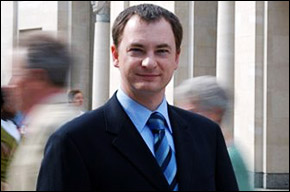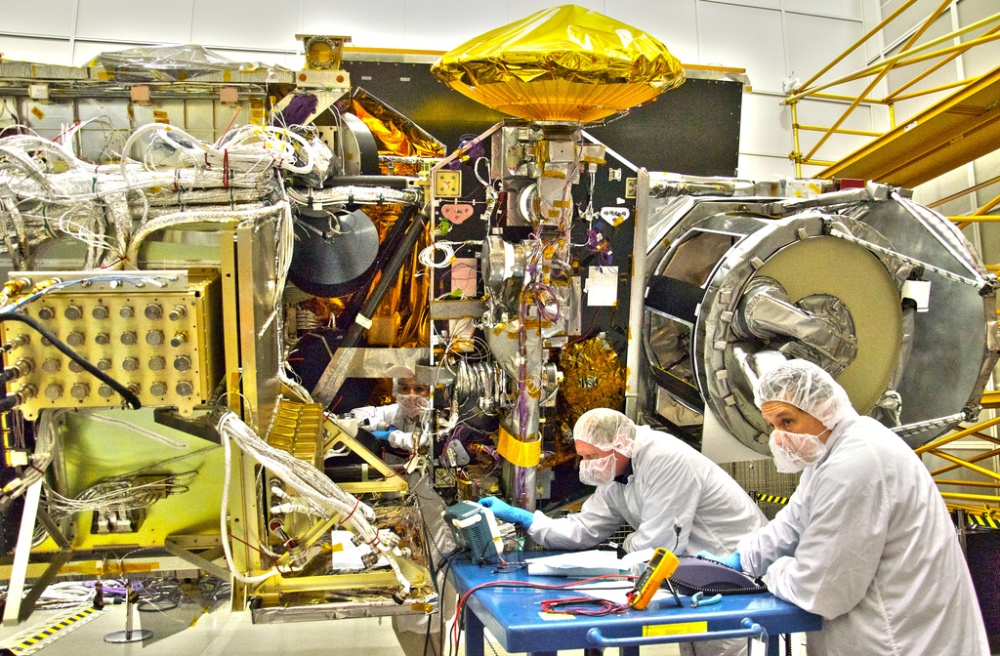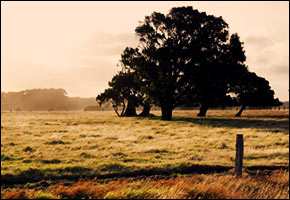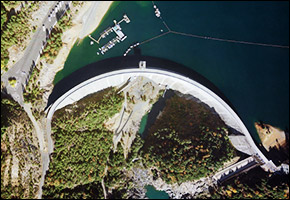Mark Turrell: Social Collaboration Tools for Changing the World
Welcome to Circle of Blue Radio’s series Five and 15, where we’re asking global thought leaders five questions in fifteen minutes, really more or less. These are experts in journalism, science, communications design, technology, and water. And really everything in between. I’m J. Carl Ganter hosting this week.
And, and at the World Economic Forum’s annual meeting in Davos, Switzerland, not only do the world’s power elite gather, but so do social and technology pioneers. These are people whose work and technology are focused on solving some of the world’s greatest challenges, such as water, climate and energy. And we keep hearing that collaboration is really the key to survival in these major issues. I am joined by Mark Turrell, CEO of Imaginatik. It’s a technology pioneer firm at the Forum, and Turrell is here to, in his words, make the world a better place. So, we thought we’d better learn from him about the new tools we’ll be seeing and what needs to be done really to make them work. I am joined by Mark.
Mark, tell us about Imaginatik and what you do.
About 17 years ago when I was doing my Ph.D., I was looking at how people actually use computer software, and I was one of the first people in the world to use server log data to see how people actually used computers, as opposed to doing interview research.
What we found then is that there are certain ways of getting people to collaborate in a computer system and certain ways of working with leadership and management to sort of take that collaborative brain power and harness it and do something useful with it. So, at Imaginatik, our software company, we have very specialized software that taps into people’s brains, sort of brain waves, insights and collaborative space to have those ideas being built out. And then a whole evaluation system, prioritization system, so that the company can actually do something with the best studies so they can actually get implemented and the company’s organization can see material benefits.
Several months ago, you and I were standing in line for food at the World Economic Forum meeting in China, and one of the first phrases after you introduced yourself was “you want to change the world for the better”. So do a lot of people, and what does that actually mean to you?
I’m probably anxious that I am changing the world for better. A lot of people want to. It’s one of those unmet needs, and if you are a consumer product company and you found an unmet need for people to stop and smell you, it would be huge and you’d end up with deodorant. I actually believe right now there is a huge unmet need in the world for people who want to do something good. They just don’t know what they should be doing.
We’ve, by and large, gone through four generations of education in most of the world, apart from the 4 billion people at the bottom of the pyramid that don’t have electricity and running water. Most people right now have got their basic needs covered, but people want to do more. I think, though, what is missing is people don’t know what they should be doing. Right now, people who want to make a change for difference typically meant drop $200 onto a credit card to give it to a charity. But, there is a lot more people wanting to be a lot smarter about what they do.
I think, also, right now, as this is being recorded in 2009, the world is faced with many, many, many problems, and the world, to a large extent, has gotten worse – for potentially some very bad things to happen. At the same time, many of the tools, the techniques, the methods to actually make a substantive difference in the world now all exist. It’s the perfect story where everything bad is happening, but at the same time now we have the tools to actually address it.
So, when I say that I am changing the world, what I’ve done is I’ve actually built a business plan than I’m executing on to change everything for the better, all at the same time. I can describe it in more detail if you’d like. You do look somewhat skeptical.
Well, if I give you an example. I mean, right now, it’s a transparency. One of the first tests to this approach was in Zimbabwe, at the first round of the election they had in March of 2008. I had met one of the opposition party leaders at the World Economic Forum in Davos and as I explained to him my plan to change the world, it was sort of evolving then. He said well okay, can you help me in Zimbabwe?
And so, what I did is I took a number of techniques, saying how do you work within a network, how do you organize within that network, how do you get the network to do something, how do you get the network to do something now rather than procrastinate, and how do you use the power of the internet in sharing to do something different, so this is really the power of photography and the power of sort of group genius.
What happened was that of the 4,000 polling stations around Zimbabwe, what they did as part of the electoral protocol is they put the election results on the front door of the polling station for about half an hour. About 1,000 people that had camera phones were encouraged to run up, take a picture, upload it to the Internet, and then tons of people that looked at every single picture that came in then immediately stuck it into a group spreadsheet, an operative spreadsheet around the world, and in 15 minutes, we had counted the votes for 35% of the country, when there was no mathematical way to pick out who would actually win the election. That was one project.
That was like the start of just to find out if this stuff works. So, there’s a number of techniques I have developed that are really relatively simple, but really make a substantive difference in changing everything in the entire world all at the same time.
So Mark, it sounds like it’s all about recognizing patterns and really acting on them. Could you elaborate some more? I’d really like to understand what’s happening here.
I should actually provide a little bit of background, because in order to look at sort of how things change, it’s important to have some sort of fundamental constructs. So, one fundamental construct is a complex system.
A complex system is where there are two or more agents acting as individuals with memories that interact. This is opposed to a linear system, where A-B-C, and a complex system, all kinds of stuff can happen. So we are, right now, with the interview, there are two people here. I could be singing. I could be dancing. There’s all kinds of things.
But, now, what’s interesting is that the complex system, even though there is a gazillion possibilities that could occur, very few . . patterns begins to emerge very quickly then, based on a principle called emergent. Emergent’s patterns begin to emerge. And there’s a book called Gut Feelings. And what Gut Feelings book says is that the reasons why patterns emerge and the reason why complex beings can actually sort of survive in a completely complex world is because we’re ruled by rules of thumb or hieristics.
A rule of thumb, for example, that’s very powerful is imitation or follow your peers. Imitation or follow your peers pretty much says do what other people are doing. So, right now, in a restaurant, nobody gives you a rule-book on how to use a restaurant. You just sit down and eat because everybody else is sitting down to eat.
Another rule is keep doing what you’re doing unless there’s a compelling reason to change. This means that a system creates its own steady state by itself. So, really complex systems, emergents, and now we have hieristics and rules of thumb.
The next is a network. So, a network is made up of two or more nodes which have got different types of connections that can be active, passive. Within a network, there are certain sort of concentrations that occur called hubs, superhubs and ultrahubs. So that network structure, be it sort of your Facebook, social type of networks, or within a corporation sort of social networks, that gives you another important structure, but once you have that, I’m going to call this network artistry, how do you get that network to do stuff? Facebook is an example of a network that’s not really doing anything.
But once a network exists, you can get the network to do stuff. You could, for example, be looking at the arts, for example, as I have been building up my model. At the South Bank Center in London, I think it was August of 2008, there was a big event where they spontaneously had hundreds of people arrive at the South Bank wearing different colored clothes, color-coded. Some of the people then sort of had bigger commitments and had bicycles. Some of them did walking. And that was all done through Facebook and MySpace.
So, what you’re talking about is mass collaboration, really pulling together people and their ideas using the latest digital tools.
So, it’s the ability to take networks and get them to do stuff.
Then, there’s something called the human laser beam effect, which is, if you look at a sort of light, took light bulbs and then related them to human light. If you look at a light bulb, it’s a fairly diffuse type of light. It just makes them bright when it’s dark. But if you look at concentrating that light, if you look at pulsing the light, sort of synchronizing the light waves, you actually get something called a laser beam.
Well, you can do a lot of stuff with lasers, a lot of stuff, more than you can do with just a simple light bulb. So, there are ways that my company, Imaginatik, has pioneered over the last 10 years; hence, why we are a technology pioneer here at Davos, to really create this human laser beam effect.
So, if you take that the world is in a complex system with emergents, where patterns emerge based on rules of thumb, that we live in a network and that by synchronizing, we can use the human laser beam effect, with that it is now fundamentally possible to start digging into most of the world’s problems fundamentally differently. And, to be honest, we don’t have much of a choice. Now is the time to actually make a difference.
Thank you, Mark. We have been at the World Economic Forum’s annual meeting in Davos, Switzerland, hearing from Mark Turrell, CEO of Imaginatik. For more on water, collaborative efforts and related issues, be sure to tune in to Circle of Blue online at 99.198.125.162/~circl731. Our theme is composed by Nadav Kahn, and we have had support today from Traverse Legal. Join us again for Circle of Blue Radio’s Five and 15. I am J. Carl Ganter.
Circle of Blue Radio is made possible with generous support from Traverse Legal.
Circle of Blue’s east coast correspondent based in New York. He specializes on water conflict and the water-food-energy nexus. He previously worked as a political risk analyst covering equatorial Africa’s energy sector, and sustainable development in sub-Saharan Africa. Contact: Cody.Pope@circleofblue.org









Very interesting interview about Imaginatik, thanks. Nice ideas about collaboration.
Perhaps Mark would be interested in lerning more about a fabric pipeline for economically moving large quantities of water through the oceans of the world using waterbag technology. He may view television news coverage of a demonstration in Washington State on YouTube and inserting the words, “Spragg Bag” in the selection box, and view photos at http://www.waterbag.com.
Try out Injoos Teamware. I would reckon that they have the most comprehensive integrated collaboration platform. With their latest release they have added a new twist to track and execute projects “the social way”. Checkout their Blog http://injoos.com/blog/2009/10/09/seamless-collaboration-with-release-35/